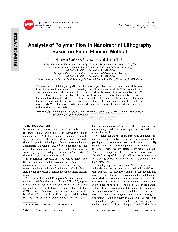摘要
Thermal nanoimprint lithography (NIL) has the advantage of high resolution and low cost, however it requires a significant amount of processing time. Finite element analysis (FEA) simulation can save research time and cost and help to understand the behavior of the polymer flow. ANSYS was employed to set up a nonlinear hyperelastic FEA model. The model was applied to analyze the resist flow during the NIL process. When the width of the stamp cavity increases or the resist thickness increases, the external pressure needed for resist flow decreases and the resist flows more easily. While the cavity depth becomes deeper, the resist needs bigger external pressure in order to fill in the cavity fully.
- 出版日期2014-8
- 单位河海大学
